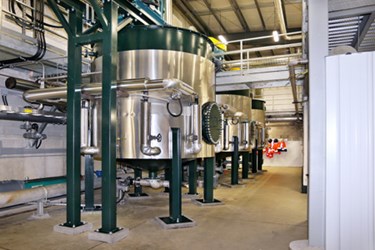Drought, Changing Regs, And Desire For Renewable Energy Results In Unique Public-Private Partnership

By Kevin Litwiller, B.BA, Director of Business Development, Lystek International Inc.
Excitement is building around a new wastewater recovery project scheduled for completion in Fairfield, CA, this coming summer. The construction and launch of Cambridge, Ontario-based Lystek International’s first U.S.-based Organic Material Recovery Center (OMRC), in partnership with the Fairfield-Suisun Sewer District (FSSD) in Fairfield, CA, is a large-scale project. It is expected to have a significant, lasting impact on biosolids and organics management and wastewater treatment for the District and surrounding Bay Area.
While advances have certainly been made, the basic premise of traditional wastewater treatment has not changed dramatically over the course of the last half century. Certainly, the process has evolved to incorporate new techniques and align with new requirements such as the reduction and/or elimination of many historical concerns (i.e., heavy metals), but the overall objective of producing clean water from wastewater remains the same.
One area that is changing rapidly, however, is the treatment and management of biosolids, which have historically had beneficial uses, most notably as a soil amendment to restore degraded conditions, to mix with compost, or for use as daily cover at landfills. This unique public-private partnership will bring new, innovative technology to the area and introduce additional uses for this valuable material. Not only will this undertaking support the existing FSSD wastewater treatment facility as it continues to function as it always has, but it will also convert what is sometimes considered “waste” into a range of fully recoverable resources with a variety of uses, making better use of effluent water.
With both organizations working together as partners, the FSSD plant will continue to produce clean water and the new Organic Material Recovery Center (OMRC – FSSD) will make full use of Lystek’s low-temperature, low-cost thermal hydrolysis technology to advance wastewater treatment. The system will convert biosolids and other organic feedstock into a Class A, Exceptional Quality (EQ) biofertilizer product, which will then be marketed and utilized in agriculture, horticulture, and for a variety of other applications in California. This unique, liquid biofertilizer is rich in organic matter (approximately 17 percent solids) and can be subsurface injected or blended with soils and other organic materials to enhance health and tilth and the ability to retain valuable moisture.
The initiative will also leverage the technology to optimize treatment plant operations. In this step, the treated material is re-introduced (fed back) to anaerobic digesters (AD) with the net results being reduced overall volumes and increased biogas production, which will then be further converted into green energy. This will subsequently help to power the FSSD plant, thereby reducing operational costs and playing an important role in the movement to convert this traditional WWTP into a Wastewater Resource Recovery Facility (WRRF). As time goes by and the process and partnership continue to evolve, the potential for additional advancements will also be explored, including co-processing of organic food waste.
Fairfield-Suisun’s existing water and wastewater treatment plant was constructed in the late 1970s. The plant has long produced a biosolid that has typically been used as daily cover at the local landfill. While this has certainly worked for many years, California regulations are changing. Going forward, certain types of organic “waste” will not be allowed in landfills. So far, the ban only applies to food waste, but it is widely expected that other organic materials (such as biosolids) will soon follow. Also, and increasingly more important, agencies are trying to find a better use for their effluent water. Therefore, the forward-thinking leadership team at FSSD recognized that the lifespan of their daily landfill cover program may be limited. As a result, the search for new and innovative uses for this material generated at the WWTP was amplified.
It was during this search that conversations were initiated with Lystek, a Canadian company that was looking for innovative expansion opportunities in the U.S. market, particularly in California. After many positive conversations, both organizations agreed there were great synergies, including the fact that the project would be able to make use of existing, under-utilized infrastructure and capacity at the FSSD plant.
As discussions progressed, synergies between the two award-winning organizations became obvious. It just made sense to combine novel, technical innovation with the existing infrastructure, capacity, and location of the FSSD plant to service the Bay Area. Through need, mutual cooperation, and proactive forward planning, a unique public-private partnership emerged between these two organizations. The project will become a reality in the early summer of 2016 when construction and initial testing are completed.
By working together in the true spirit of partnership, this development will play an important role in helping to move the biosolids and organics management industry forward in the Bay Area. It will produce exceptional quality products and provide solutions to area growers that are stressed by drought and depleted soil conditions. It will also enhance wastewater treatment plant operations through the implementation of processes that will reduce overall volumes while producing green energy. Aside from local interest, there is also great interest from similar organizations across California and throughout the U.S. and Canada, all of whom are keen to see the successful outcome of this partnership.
